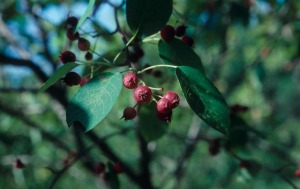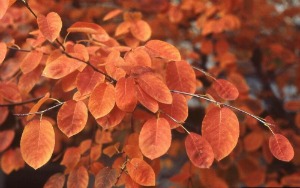Fall is a great time of the year to enjoy all of the wonderful different colors of the trees. We can find trees and shrubs in green, yellow, orange, red, and brown all at the same time. One of the small trees or large shrubs that turns a beautiful red or yellow color, depending on the variety, in the fall is Serviceberry, which is the October plant of the month selection.
Shadblow Serviceberry, Amalanchier Canadensis, is a great plant for Nebraska landscapes, as it is a native tree. It can be grown either as a large shrub or a small tree, depending on how it is pruned. This tree grows to 20 feet tall. Serviceberry leaves are arranged alternately on the stem and are oblong with fine teeth along the edges of the leaves without lobes. The leaves are fuzzy when young, but become smooth as they age. This species of serviceberry turns yellow in the fall, but there are other species and varieties that turn red in the fall. Serviceberry plants produce a small red berry that turns black in the early summer. The fruits are edible, but you have to beat the birds to them.
There are many other species and varieties of serviceberry that will do well in our environment and have many other attributes that we would enjoy on our acreages and in our landscapes. Saskatoon serviceberry is a good choice for better fruit production, as this species produces larger fruit. There is a variety of this species, 'Regent', that has very good fall color as well. Autumn Brilliance serviceberry is a past Great Plants for the Great Plains selection and has a brilliant red color to the leaves in the fall. Coles Select serviceberry is another good, red fall color choice. It is similar to the Autumn Brilliance serviceberry but is more tolerant of the heat and more consistent in the red fall color.
Shadblow Serviceberry is a good tree for many locations on your acreage or in your landscape. It does well as an understory tree, so it tolerates both sun and part shade locations, but it prefers part shade. It also tolerates both wet and dry soil locations. Serviceberry trees can be used as a specimen plant, as an understory tree or shrub, under power lines, or planted in groupings as a border or screen.
Serviceberry trees or shrubs can be planted to help the wildlife for food and for habitat. Birds relish the berries. Serviceberry plants are also great to plant for pollinators. The University of Maine Extension states that Serviceberry is an early nectar source for bees and butterflies. Serviceberries can be made into many products including pies, jams, puddings, syrups, and muffins. The berries have a good nutritional value because they are high in iron and copper, according to the University of Alaska Fairbanks Cooperative Extension Service.
Serviceberry is a great tree to plant on any acreage or in any urban landscape setting as well. They have a great appeal for their amazing fall colors and produce tasty berries for us and for wildlife. So the next time you are looking to plant a new, smaller tree or larger shrub, look to Serviceberry and choose the species to fit your individual needs. The photo of serviceberry in Fall color below is from T. Davis Sydnor, The Ohio State University, Bugwood.org


